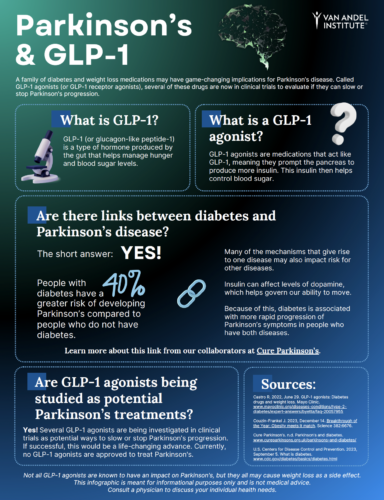How a ‘blockbuster’ treatment for diabetes and obesity might slow or stop Parkinson’s
Oct. 14, 2024: This article has been updated to include information about the phase 3 exenatide trial.
February 15, 2024

A “blockbuster” weight loss medication hailed as the “2023 Breakthrough of the Year” by Science also may have game-changing implications for Parkinson’s disease.
The medication belongs to a family of drugs called GLP-1 agonists, which were developed and initially approved to treat Type 2 diabetes.
Two years ago, one of these drugs, semaglutide, also was approved as an obesity treatment in the U.S., sparking an explosion in public interest. Semaglutide is having a cultural moment but, as Science points out, not everything is clear cut. GLP-1 agonists still are medications and, like all medications, have risks of side effects. There also is a tangled web of medical and social factors surrounding obesity, all of which are shadowed by persistent stigma around weight.
Much of the discussion about GLP-1 agonists has focused on weight loss and diabetes. But there is another important possibility offered by these medications — their potential as disease-modifying treatments for Parkinson’s disease.
But how do GLP-1 agonists work and how might they be useful in Parkinson’s? In the rest of this post, we’ll explore what these medications do, how they could impact Parkinson’s, and the steps being taken to evaluate their possible utility in Parkinson’s.
What is GLP-1 and why does it matter?
GLP-1 (or glucagon-like peptide-1) is a type of hormone produced by the gut that helps manage hunger and blood sugar levels.
We still don’t know everything about how GLP-1 works, but we do know that it causes the pancreas to produce more insulin. This is an important task — insulin helps control blood sugar by shepherding sugar from the food we eat to our cells for immediate use as fuel or to storage for later use.

GLP-1.
In diabetes, the body is unable to make sufficient insulin (Type 1 diabetes) or insulin becomes less effective at its job (Type 2 diabetes). When this happens, too much sugar stays in the bloodstream, where it can cause serious problems such as vision loss, tissue damage and heart disease.
Treatment with supplemental insulin, such as injections, is a primary treatment for diabetes. However, insulin injections do not fix the underlying problems that contribute to diabetes. Other medications, such as those that act like GLP-1, also are used to treat diabetes.
What are GLP-1 agonists?
GLP-1 agonists are medications that act like GLP-1, meaning they prompt the pancreas to produce more insulin. This insulin then helps control blood sugar.
Importantly, GLP-1 agonists also have been shown to have protective effects in the brain. Studies in models of Parkinson’s disease suggest these medications may decrease inflammation, enhance cellular energy production, and improve the function of critical brain cells associated with movement — all processes that are known to be impacted by Parkinson’s.
How might a diabetes drug help treat Parkinson’s?
“Health” is a seemingly simple term that represents an immensely complex network of interconnected, overlapping systems. This means that many of the mechanisms that give rise to one disease may also impact risk for other diseases.
Diabetes and Parkinson’s disease are prime examples. As our collaborators at Cure Parkinson’s note in this post, many people with Parkinson’s also have glucose intolerance or diabetes. Likewise, people with diabetes have a 40% greater risk of developing Parkinson’s compared to people who do not have diabetes. Diabetes also is associated with more rapid progression of Parkinson’s symptoms in people who have both diseases.
One more thing — insulin helps manage blood sugar in the brain and can affect levels of dopamine, a chemical messenger that helps govern our ability to move. In Parkinson’s, dopamine-producing cells die, which starves the brain of dopamine and leads to the disease’s hallmark movement-related symptoms. As such, maintaining the body’s ability to produce and use insulin effectively may have major implications for Parkinson’s in addition to diabetes.
Are GLP-1 agonists being studied as potential Parkinson’s treatments?
Yes! Several GLP-1 agonists are being investigated in clinical trials as potential ways to slow or stop Parkinson’s progression. If successful, this would be a life-changing advance. Right now, we do not have any approved ways to impede the course of the disease.
Clinical trials are critically important. They enable researchers to evaluate the safety and effectiveness of medications, while also controlling for factors that may influence results. As of now, there are no GLP-1 agonists approved for treatment of Parkinson’s disease.
Several of these trials are part of Cure Parkinson’s and Van Andel Institute’s International Linked Clinical Trials program, which investigates whether medications developed for other diseases may also have applicability in Parkinson’s. Several GLP-1 agonists are part of this program, including:
- Exenatide: Results from a large, phase 2 trial in 2017 suggested that exenatide may slow Parkinson’s progression. A phase 3, multi-center trial called the Exenatide PD3 Study is coming to an end in the United Kingdom, with initial results expected in summer 2024. (Oct. 14, 2024: Initial exenatide trial results are now available. Read more ➔)
- Lixisenatide: Initial results from a proof-of-concept phase 2 trial conducted in France are expected this year. Read more about the trial here.
This article is meant for informational purposes only and is not medical advice. Consult a physician to discuss your individual health needs.
Sources
Castro R. 2022, June 29. GLP-1 agonists: Diabetes drugs and weight loss. Mayo Clinic.
Couzin-Frankel J. 2023, December 14. Breakthrough of the Year: Obesity meets it match. Science 382:6676.
Cure Parkinson’s. n.d. Parkinson’s and diabetes.
U.S. Centers for Disease Control and Prevention. 2023, September 5. What is diabetes.

